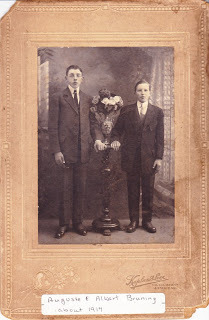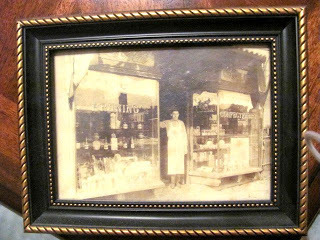The Candyman - Bruning Brothers Confectionary
The Candyman
Bruning Brothers Confectionary
 A German immigrant, my grandfather, August Bruning began his American business dream with his younger brother Albert during the early part of the 20th century along the east coast. Bruning Brother Confectionary ran for many years between New Jersey and New York only to turn into Bruning Ice Cream mid century.
A German immigrant, my grandfather, August Bruning began his American business dream with his younger brother Albert during the early part of the 20th century along the east coast. Bruning Brother Confectionary ran for many years between New Jersey and New York only to turn into Bruning Ice Cream mid century.
During the beginning of the twentieth century the local confectionary was the place to be for any youngster. Webster's dictionary defines a confection as any sweet food such as candy or pastry. A confectioner was the person who crafted the treat and his shop contained the most delicious treats he or she made from sugar. Today confectionary stores are hard to find in United States. Some local and regional stores exist within small towns yet commercialization has threatened these small business owners through supply and demand. Most of the modern day confections can be found anywhere from general stores to gas stations.
In the United States we call any confection, candy. Yet travel around the world and you may encounter different names. For example, in Australia and New Zealand candy is often referred to as "lollies". Britain, Ireland and other commonwealth states use the term "sweet." Confections come in a wide variety of categories. These include yet not limited to: toffee, fudge, hard sweets and liquorices. While they taste good, moderation is best. Constant intake of any sweet may lead to type 2 diabetes or tooth decay.
In my grandfather's days the supermarkets and convenience stores didn't exist for large candy makers, such as Hersey's, to market their products. Youngsters drove towards their local confectionary store to satisfy their sweet tooth. A trip into one of these stores was wonderland for any child. All types of candy displayed everywhere for the eye to see in a wide variety of color and imagination. I'm often reminded of the "Candy Man" from the 1971 movie "Willy Wonka and the Chocolate Factory." (my father, Roland Irving Bruning, loved that movie. So do I.)
Throughout the 19th century all candy had been sold to the consumer through loose small piece that were weighed, bought then bagged. In the early 20th century, the time of Bruning Brothers Confections, commercial confectionary stores grew rapidly across the United States. Local confectionaries began to experiment with their own localized candy bar creations. Today some of these regional candy bars have become household names, such as Hersey and Mars.
 My grandfather, August Bruning, outside his candy store.I am proud of my grandfather who became a piece of American history as one of these confectionary owners. It's a shame the small town confectionaries have become a place of our past and not of our future as commercialization threatens our small town businesses. Next time you have a chance to visit a local confectionary store remember men such as my grandfather who dared to dream of chocolate, sugar, fun and children. The candyman.
My grandfather, August Bruning, outside his candy store.I am proud of my grandfather who became a piece of American history as one of these confectionary owners. It's a shame the small town confectionaries have become a place of our past and not of our future as commercialization threatens our small town businesses. Next time you have a chance to visit a local confectionary store remember men such as my grandfather who dared to dream of chocolate, sugar, fun and children. The candyman.

 A German immigrant, my grandfather, August Bruning began his American business dream with his younger brother Albert during the early part of the 20th century along the east coast. Bruning Brother Confectionary ran for many years between New Jersey and New York only to turn into Bruning Ice Cream mid century.
A German immigrant, my grandfather, August Bruning began his American business dream with his younger brother Albert during the early part of the 20th century along the east coast. Bruning Brother Confectionary ran for many years between New Jersey and New York only to turn into Bruning Ice Cream mid century. During the beginning of the twentieth century the local confectionary was the place to be for any youngster. Webster's dictionary defines a confection as any sweet food such as candy or pastry. A confectioner was the person who crafted the treat and his shop contained the most delicious treats he or she made from sugar. Today confectionary stores are hard to find in United States. Some local and regional stores exist within small towns yet commercialization has threatened these small business owners through supply and demand. Most of the modern day confections can be found anywhere from general stores to gas stations.
In the United States we call any confection, candy. Yet travel around the world and you may encounter different names. For example, in Australia and New Zealand candy is often referred to as "lollies". Britain, Ireland and other commonwealth states use the term "sweet." Confections come in a wide variety of categories. These include yet not limited to: toffee, fudge, hard sweets and liquorices. While they taste good, moderation is best. Constant intake of any sweet may lead to type 2 diabetes or tooth decay.
In my grandfather's days the supermarkets and convenience stores didn't exist for large candy makers, such as Hersey's, to market their products. Youngsters drove towards their local confectionary store to satisfy their sweet tooth. A trip into one of these stores was wonderland for any child. All types of candy displayed everywhere for the eye to see in a wide variety of color and imagination. I'm often reminded of the "Candy Man" from the 1971 movie "Willy Wonka and the Chocolate Factory." (my father, Roland Irving Bruning, loved that movie. So do I.)
Throughout the 19th century all candy had been sold to the consumer through loose small piece that were weighed, bought then bagged. In the early 20th century, the time of Bruning Brothers Confections, commercial confectionary stores grew rapidly across the United States. Local confectionaries began to experiment with their own localized candy bar creations. Today some of these regional candy bars have become household names, such as Hersey and Mars.
 My grandfather, August Bruning, outside his candy store.I am proud of my grandfather who became a piece of American history as one of these confectionary owners. It's a shame the small town confectionaries have become a place of our past and not of our future as commercialization threatens our small town businesses. Next time you have a chance to visit a local confectionary store remember men such as my grandfather who dared to dream of chocolate, sugar, fun and children. The candyman.
My grandfather, August Bruning, outside his candy store.I am proud of my grandfather who became a piece of American history as one of these confectionary owners. It's a shame the small town confectionaries have become a place of our past and not of our future as commercialization threatens our small town businesses. Next time you have a chance to visit a local confectionary store remember men such as my grandfather who dared to dream of chocolate, sugar, fun and children. The candyman.
Published on February 27, 2012 08:00
No comments have been added yet.



